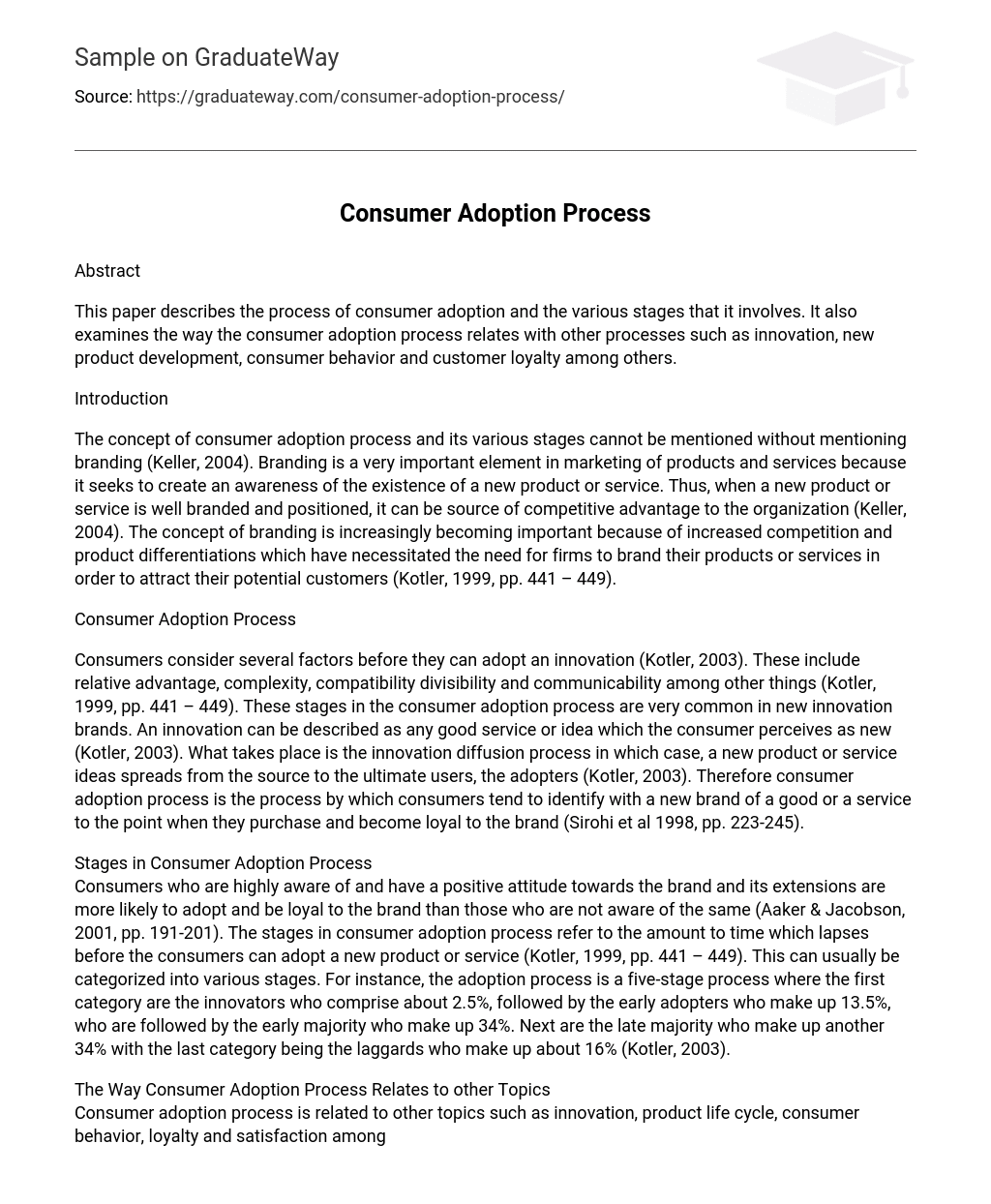Abstract
This paper describes the process of consumer adoption and the various stages that it involves. It also examines the way the consumer adoption process relates with other processes such as innovation, new product development, consumer behavior and customer loyalty among others.
Introduction
The concept of consumer adoption process and its various stages cannot be mentioned without mentioning branding (Keller, 2004). Branding is a very important element in marketing of products and services because it seeks to create an awareness of the existence of a new product or service. Thus, when a new product or service is well branded and positioned, it can be source of competitive advantage to the organization (Keller, 2004). The concept of branding is increasingly becoming important because of increased competition and product differentiations which have necessitated the need for firms to brand their products or services in order to attract their potential customers (Kotler, 1999, pp. 441 – 449).
Consumer Adoption Process
Consumers consider several factors before they can adopt an innovation (Kotler, 2003). These include relative advantage, complexity, compatibility divisibility and communicability among other things (Kotler, 1999, pp. 441 – 449). These stages in the consumer adoption process are very common in new innovation brands. An innovation can be described as any good service or idea which the consumer perceives as new (Kotler, 2003). What takes place is the innovation diffusion process in which case, a new product or service ideas spreads from the source to the ultimate users, the adopters (Kotler, 2003). Therefore consumer adoption process is the process by which consumers tend to identify with a new brand of a good or a service to the point when they purchase and become loyal to the brand (Sirohi et al 1998, pp. 223-245).
Stages in Consumer Adoption Process
Consumers who are highly aware of and have a positive attitude towards the brand and its extensions are more likely to adopt and be loyal to the brand than those who are not aware of the same (Aaker & Jacobson, 2001, pp. 191-201). The stages in consumer adoption process refer to the amount to time which lapses before the consumers can adopt a new product or service (Kotler, 1999, pp. 441 – 449). This can usually be categorized into various stages. For instance, the adoption process is a five-stage process where the first category are the innovators who comprise about 2.5%, followed by the early adopters who make up 13.5%, who are followed by the early majority who make up 34%. Next are the late majority who make up another 34% with the last category being the laggards who make up about 16% (Kotler, 2003).
The Way Consumer Adoption Process Relates to other Topics
Consumer adoption process is related to other topics such as innovation, product life cycle, consumer behavior, loyalty and satisfaction among other in various ways. For instance the consumer adoption process is related to the product life cycle in the sense that both are processes (Kotler, 1999, pp. 441 – 449). In other words, the adoption process does not take place at once but takes place in stages just like the product life cycle or the process of developing a new product (Kotler, 2003). Therefore just like in developing a new product, innovative organizations will ensure that at the end of each stage of the adoption process, an evaluation is carried out before the next stage is reached. At the end of the day therefore, the poor ideas are likely to be eliminated before they reach the market (Kotler, 2003).
Conclusion
In conclusion, the rate of consumer adoption varies from one product to the other. The innovators are usually the first to adopt a new product or service and they represent 2.5% while the early adopters comprise a further 13.5% of the population (Kotler, 1999, pp. 441 – 449). The marketer should therefore target these two categories by way of effective communication according to the demographic and media consumption characteristics that they display. The rationale for this is that once they have adopted the product, they are likely to spread that influence to the late adopters by way of personal influence which is a more positive strategy than any other communication efforts (Kotler, 2003).
References
Aaker, D. A., & Jacobson R. (1994) The Financial Information Content of
Perceived Quality, Journal of Marketing Research, pp. 191-201.
Keller, K.L. (2004). Strategic Brand Management: Building, Measuring, and
Managing Brand Equity. Delhi, India: Pearson Education.
Kotler, P. (2003). Marketing Management, 11th ed., New Jersey: Prentice Hall.
Kotler, P. (1999). Marketing Management: Analysis, Planning, Implementation
and Control, Prentice Hall Inc., 7th Ed. pp. 441 – 449.
Sirohi, N., McLaughlin, E.W., & Wittink, D. R. (1998). A Model of
Consumer Perceptions and Store Loyalty Intentions for a Supermarket. Journal of Retailing, 74 (2), pp. 223-245.





